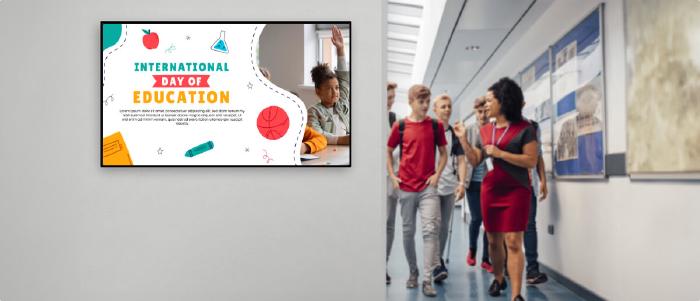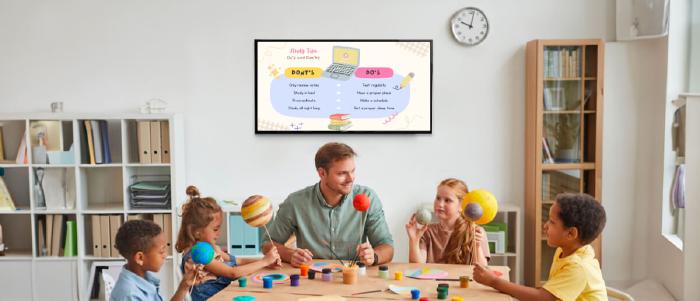
Mar 25 2024
6 min read

Education and technology have been each other’s perfect complements since time immemorial. But have you considered how the smallest of innovations can revolutionize institutional learning? Be it in terms of what you see in classrooms or across a campus, tech has us indelibly gripped. One such example is digital wayfinding for colleges and universities. Unfamiliar with what it might mean? We have got you covered!
College wayfinding signage means the strategic design and implementation of navigational systems, including signage, maps, and digital tools, to assist students, staff, and visitors in navigating and locating specific destinations within the campus environment. It helps enhance premise accessibility, helping locate particular areas and showing directions. This reduces confusion and optimizes the overall experience for everyone.
Here are the commonly used indoor navigation solutions implemented in colleges and universities:
These provide general details about various campus landmarks, facilities, and destinations. Informational signs help individuals, especially newcomers, become familiar with the campus environment by offering descriptions or essential information about points of interest and noteworthy facilities.
Strategically positioned throughout the campus, directional signs are crucial in guiding people efficiently to their intended destinations. These signs typically feature prominently displayed arrows that point in specific directions, indicating the routes individuals should take to reach various locations. Whether finding a particular building, department, or facility, digital directories simplify navigation and reduce confusion, ensuring that individuals can easily traverse the campus.
Identification signs display relevant information such as building names, department titles, or designated areas. By prominently showcasing these identifiers, these signs help visitors and campus community members establish their location within the larger campus context.

Campus map signs provide a complete wayfinding overview of key landmarks, pathways, and critical areas on the campus. Maps often include labeled icons representing buildings, recreational spots, parking areas, and other relevant features. They enable individuals to chart their routes, locate specific destinations, and make informed decisions about their navigation.
These campus wayfinding signs help communicate rules, regulations, and restrictions. Whether indicating speed limits, no-entry zones, parking regulations, or other campus-specific guidelines, regulatory signs contribute to a secure and organized campus environment. By promoting compliance, these signs help prevent accidents and conflicts.
Emergency signs are critical in enhancing premise safety by providing quick and accessible information during urgent situations. These signs guide individuals to essential resources such as emergency exits, first aid stations, fire extinguishers, and assembly points. Clear and well-lit emergency signs ensure individuals can quickly respond to unexpected incidents and emergencies.
Interactive digital wayfinding signage often features an interface such as an electronic screen or booth that allows users to input their destinations or preferences. In response, the signs generate real-time directions, maps, and additional information tailored to the user’s needs. Interactive characters can also provide updates about ongoing campus events, news, and other relevant content. These signs enhance navigation convenience and engagement by merging digital innovation with wayfinding.
Wayfinding solutions in complex architectures such as large university campuses are gaining increasing prominence among renowned universities. Here are a few notable examples.
At the UNSW Clinical School in Australia, a cutting-edge digital wayfinding solution is clubbed with an innovative technique known as glass projection.
Glass projection is an advanced method that projects visuals, like images and text, onto surfaces using projectors and software. It creates interactive experiences on transparent or semi-transparent screens, from simple graphics to complex displays. This technique finds value in indoor spaces like buildings, museums, retail, and education. Additionally, the university utilizes an app as a virtual guide that assists users in effortlessly navigating the campus’ indoor and outdoor areas.
NUS utilizes a blend of fixed signs and digital information kiosks to show unchanging and changing maps with routes. These interactive kiosks share details of the campus map, ongoing activities, and essential info such as emergency protocols, SOPs on the premises, etc.
The digital kiosks serve as informative hubs that offer a dynamic perspective on the surroundings. It helps showcase maps that adapt based on real-time changes, ensuring accuracy and up-to-date guidance. This type of campus wayfinding signage benefits newcomers, visitors, and even regular students and staff who might need assistance navigating the vast and evolving campus environment.

Princeton University enhanced navigation with a new wayfinding system for its expanding campus. The approach included user-friendly map kiosks at key entrances, offering updated maps with landmarks, and even noting construction updates. The new map system features “neighborhoods” to help users orient themselves and locate campus destinations.
Alongside physical signage enhancements, an interactive kiosk showing the campus map is being developed to offer accessible routing and real-time event data for specific locations. The University aims to build a hospitable, user-centric atmosphere for visitors and the campus community.
Enhanced Accessibility:
Campus wayfinding signage simplifies navigation for all individuals, including newcomers and those with disabilities, by providing clear directions to critical locations. For instance, prominent signs directing to the library or student center ensure easy access to these facilities.
Time and Energy Savings:
Efficient wayfinding signage reduces wasted time getting lost or asking for directions. Signs directing people to different dining facilities, cafes, and food courts help students and visitors quickly locate places to eat, saving time and fueling them for their day.
Improved Safety:
Well-placed signs contribute to campus safety by guiding individuals to emergency exits, first aid stations, and other critical areas during emergencies. Examples include emergency exit kiosks with directions to fire doors and shortcuts around the building to guide students when exigent evacuation might be needed.
Positive Visitor Experience:
For prospective students, parents, and guests, clear signage creates a positive first impression and fosters a welcoming atmosphere. Installing signs along a designated route for a self-guided “Campus Highlights Tour” ensures that visitors can explore and appreciate the best features of the campus without feeling lost.
Brand Identity Reinforcement:
Consistent, branded wayfinding signage reinforces the identity of the educational institution. Think of signs displaying the college’s logo or motto strategically placed throughout the campus to instill a sense of belonging and pride in the community.
As technology advances, campus wayfinding signage holds re-imagining innovative elements like augmented reality navigation, personalized mobile apps, and interactive mapping. These enhancements streamline navigation, offer real-time updates, enhance accessibility, and deepen connections with campus environments. Sustainability will also play a vital role in promoting eco-friendly materials and energy-efficient displays.

Mar 25 2024
6 min read

Mar 1 2024
6 min read

Jul 29 2022
12 min read

Apr 18 2022
10 min read
Take complete control of what you show on your digital signage & how you show it.
Start Free Trial Schedule My DemoSee How Hamlin Robinson Increased Student Engagement by 25% and Reduced Info Gaps by 15%
Unlock Exclusive Insights